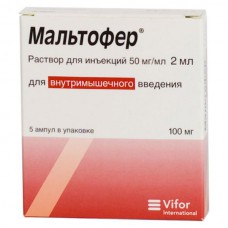Expiration date: 09/2026
The composition and form of issue:
Solution for intramuscular injection. 1 ml contains:
iron in the form polymaltose complex iron (III) hydroxide 50 mg
excipients: sodium hydroxide hydrochloric acid water for injections
in vials of glass type I 2 ml, in cartons of 5 ampoules.
Description pharmaceutical form:
Solution brown.
Pharmacokinetics:
After the/m injection, iron (III)-hydroxide polymaltose in the form of the active ingredient is absorbed mainly by the liver. There he is included in the composition of hemoglobin, myoglobin and iron-containing enzymes and is stored as ferritin. The response from the blood counts when parenteral iron is not faster than oral iron salts have patients for whom they are effective. Like other iron preparations, the Antibiotic solution for intramuscular injection has no effect on ineffective erythropoiesis and anemia not related to iron deficiency.
After intramuscular injection, the complex enters the bloodstream through the lymphatic system. Iron Cmax is reached approximately 24 h after injection. Plasma macromolecular complex falls into the reticuloendothelial system where it is broken down into components, ferric hydroxide and polymaltose. Slow release iron is the cause of his good endurance. Within the bloodstream, iron binds to transferrin in the tissues is stored as part of ferritin in the bone marrow is included in the hemoglobin and is used in the process of erythropoiesis. Excreted only small amounts of iron. Polymaltose metabolized by oxidation or excreted in unchanged form.
Small amounts of unchanged complex can pass through the placental barrier and a small amount passes into breast milk. Iron associated with the San or transferrin, can pass through the placental barrier, and in the composition of lactoferrin into the breast milk in small amounts.
Data on the pharmacokinetics of the drug in patients with iron deficiency anemia not.
It is well known that incorporation of iron in protoporphyrin depends on the severity of iron deficiency anemia. It is intense in the case of low hemoglobin levels and decreases the normalization of hemoglobin levels.
The utilization of iron may not be higher than the iron binding capacity the ability of transport proteins.
Influence of renal and hepatic insufficiency on the pharmacological properties of iron (III)-hydroxide of polymaltose unknown. The toxicity of the drug is very low. LD50 determined for white mice, at/in the introduction of the drug Acyclovir in the form of a solution for I/m injection amounted to more than 2500 mg/kg Fe, which is 100 times lower than for ordinary iron salts.
Indications:
treatment of iron deficiency in the case of lack of effectiveness, inefficiency or impossibility of oral administration dosage (for example in individuals who cannot tolerate or do not respond to therapy with oral iron preparations, patients suffering from malabsorption or disagree for a long time and regularly use oral iron, patients with gastrointestinal disease (ulcerative colitis), in which the iron preparations for oral administration can provoke exacerbation of the disease
Maltofer solution for intramuscular injection is introduced only when confirmed by the research of iron-deficiency condition (e.g. measurement of serum ferritin levels, hemoglobin, hematocrit or number of red blood cells, as well as their parameters — average corpuscular volume, average content of hemoglobin in the erythrocyte or the average concentration of hemoglobin in the erythrocyte).
Introduction children under 4 months of age is not recommended due to lack of experience.
Contraindications:
- hypersensitivity
- anaemia not related to iron deficiency (hemolytic, megaloblastnaya caused by the lack of vitamin B12)
- disorders of erythropoiesis
- bone marrow hypoplasia
- excess iron in the body (hemochromatosis, gemosideros)
- violation of recycling iron (sideroahrestical anemia, thalassemia, lead anemia, late porphyria skin)
- the syndrome of Osler-Rendu Weber
- chronic polyarthritis
- bronchial asthma
- infectious diseases of the kidney in the acute stage
- uncontrolled hyperparathyroidism
- decompensated liver cirrhosis
- infectious hepatitis
- The first trimester of pregnancy
- use for/in the introduction.
Application of pregnancy and breast-feeding:
Pregnancy category C. Experimental study of the reproduction, as well as controlled studies in pregnant women with this drug was conducted. Thus the drug in the vials may be used only in cases where the result of treatment outweighs the potential risk to the fetus.
Contraindicated in the first trimester of pregnancy, in II and III trimestrah.
Small amounts of unaltered iron from polymaltose complex can penetrate into breast milk, however, it is unlikely the occurrence of undesirable effects in bottle-fed infants.
Side effects:
In rare cases, joint pain, swollen lymph nodes, fever, headache, malaise, gastrointestinal disorders, nausea, vomiting, which are treated symptomatically.
Very rarely can develop an allergic or anaphylactic reaction.
The wrong technique of injections can lead to staining of the skin, the appearance of pain, inflammation at the injection site.
Drug interactions:
ACE inhibitors increase systemic effects. Should not be administered concomitantly with oral iron preparations (decreases iron absorption from the gastrointestinal tract). Therefore, the treatment with oral iron-containing preparations should begin no earlier than 1 week after the last injection.
Method of application and dose:
/M. Before the first introduction is necessary to conduct a test intramuscular: adults: 1/4 to 1/2 dose (25-50 mg iron), children — 1/2 the daily dose in the absence of side reactions for 15 min fill in the rest of the starting dose. The dosage is selected and calculated individually in accordance with the common iron deficiency according to the following formula:
Total iron deficit in mg = body weight in kg × (normal level Hb ? the Hb level of the patient), g/l × 0,24* + iron reserves, mg.
When body weight less than 35 kg: normal level of Hb=130 g/l, which corresponds to the hardware inventory = 15 mg/kg of body weight.
Body weight above 35 kg: normal level of Hb=150 g/l, which corresponds to the hardware inventory = 500 mg.
*The factor 0,24 = 0,0034×0,07×1000 (iron content of hemoglobin = 0.34 percent blood volume = 7% of body weight factor 1000 = transfer from g to mg).
The total number of vials for administration = total iron deficit (mg)/100 mg (see table).
Table
The total number of ampoules for injection
| Body weight, kG | The total number of ampoules for injection | |||
| Hb 60 g/l | Hb 75 g/l | Hb 90 g/l | Hb 105 g/l | |
| 5 | 1,5 | 1,5 | 1,5 | 1 |
| 10 | 3 | 3 | 2,5 | 2 |
| 15 | 5 | 4,5 | 3,5 | 3 |
| 20 | 6,5 | 5,5 | 5 | 4 |
| 25 | 8 | 7 | 6 | 5,5 |
| 30 | 9,5 | 8,5 | 7,5 | 6,5 |
| 35 | 12,5 | 11,5 | 10 | 9 |
| 40 | 13,5 | 12 | 11 | 9,5 |
| 45 | 15 | 13 | 11,5 | 10 |
| 50 | 16 | 14 | 12 | 10,5 |
| 55 | 17 | 15 | 13 | 11 |
| 60 | 18 | 16 | 13,5 | 11,5 |
| 65 | 19 | 16,5 | 14,5 | 12 |
| 70 | 20 | 17,5 | 15 | 12,5 |
| 75 | 21 | 18,5 | 16 | 13 |
| 80 | 22,5 | 19,5 | 16,5 | 13,5 |
| 85 | 23,5 | 20,5 | 17 | 14 |
| 90 | 24,5 | 21,5 | 18 | 14,5 |
Dosage: adults: 1 amp. daily (2 ml = 100 mg of iron) to children the dosage is determined depending on the body mass.
The maximum allowable daily dose is: children weighing up to 5 kg — 1/4 amp. (0.5 ml = 25 mg of iron), from 5 to 10 kg — 1/2 amp. (1 ml = 50 mg iron), adults — 2 amp. (4 ml = 200 mg of iron). If the required dose exceeds maximum daily dose, the drug should be a fraction. If the response from the haematological parameters (e.g. increase in the level of haemoglobin of about 0.1 g/DL per day) 1-2 weeks, the initial diagnosis should be reviewed. The total dose for a course of treatment should not exceed the calculated number of vials.
The injection technique is critical. As a result of improper administration of the drug can experience pain and staining of the skin at the injection site. The following method of ventro-gluteal injection is recommended instead of the conventional in the upper outer quadrant of the gluteus Maximus muscles:
a) needle length should be at least 5-6 cm of the Lumen of the needle should not be too broad. For children and also for adults with small body mass of the needle should be shorter and thinner
b) in accordance with the recommendations of Ferdinand Hochstetter, the place of injection is determined as follows (see figure 1): on the line of the spine at the level corresponding to the lumbar-iliac articulation, to fix the point A. If the patient lies on his right side, place the middle finger of the left hand at point A. to Put the index finger from the middle so that it was below the line of the iliac crest at the point B. the Triangle, located between the proximal phalanges of middle and index fingers is the injection site (see figure 2). Tools are disinfected in the usual method
c) before you insert the needle, it is necessary to move the skin about 2 cm (see figure 3) in order to close the puncture channel after removal of the needle. It prevents the penetration of solution injected into the subcutaneous tissue and skin staining
d) vertically positioning the needle relative to the skin surface at a large angle to the point of the iliac articulation than to the point of the hip joint (see Fig. 4)
e) after injection, slowly remove the needle and press with your fingers the area of the skin adjacent to the injection site, about 5 min.
f) after the injection the patient must move.
Overdose:
Symptoms: to date no cases of overdose of iron was not reported. Overdose can cause acute iron overload, which is manifested symptoms of hemosiderosis. Chronic iron overload leads to the development of hemochromatosis. This can occur in setting of misdiagnosis of iron deficiency anemia in the case of sustained treatment of anemia.
Treatment: hemochromatosis should be treated as thalassemia (in/with the introduction of deferoxamine). With the introduction of Acyclovir in too high doses, the complex can not be removed from the body by hemodialysis because of its high molecular weight. Periodic monitoring of serum ferritin levels may help in timely detection of progressive accumulation of iron.
Special instructions:
Before use, the vials should be inspected for sediment and damage. You can use only vials without sediment and damage.
The drug Acyclovir in the form of a solution for intramuscular injection should be administered immediately.
The child appeared in the form of a solution for intramuscular injection should not be mixed with other therapeutic agents.
Parenteral iron preparations can cause allergic and anaphylactic reactions. In the case of a moderately severe allergic reactions, should prescribe antihistamines with the development of severe anaphylactic reactions need immediate administration of epinephrine. Must be available means of cardiopulmonary resuscitation.
Use caution when administering drug to patients with allergies and hepatic and renal failure.
Side effects, resulting in patients with cardiovascular disease can aggravate the course of underlying disease.
Patients with asthma or low iron binding capacity the ability of serum and/or insufficiency of folic acid are at high risk of allergic or anaphylactic reactions.
In children parenteral iron preparations can affect the course of infectious process.
Effect on driving and operating machinery. Unlikely.
Maltofer
(Iron
(III)
hydroxide
polymaltose)
50mg/ml
2ml
5
vials
- Brand: Vifor


